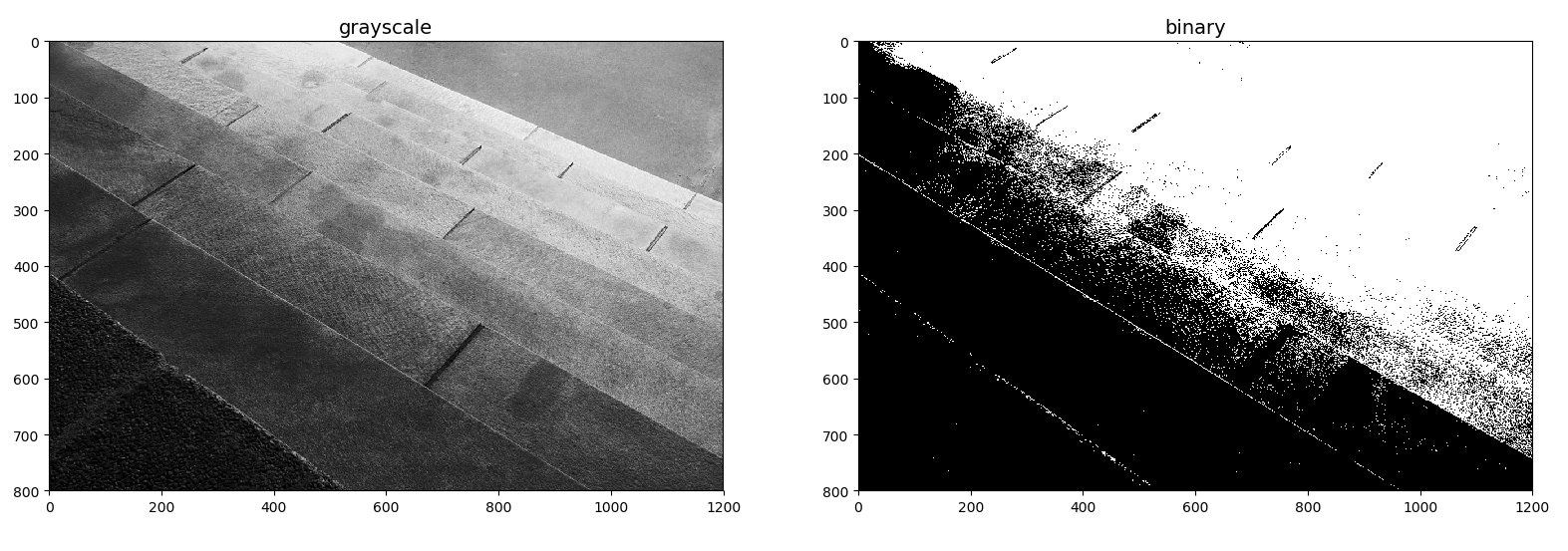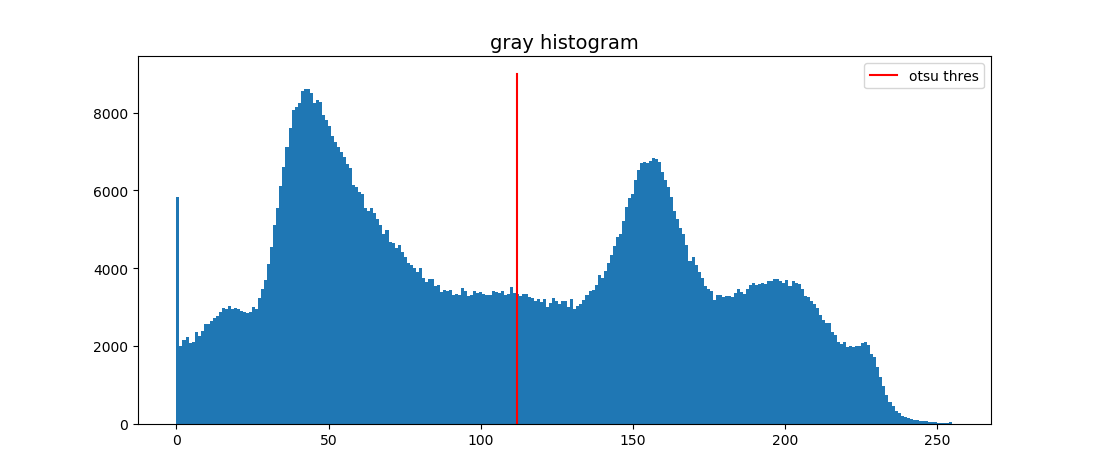Otsu の method
大津(Otsu)算法是图像领域一个基础的二值化方法,由 日本人 大津展之 于1979年提出。
日本人 大津展之 于1979年提出。
大津算法的输入为灰度图,在灰度图上求得一个自适应阈值,以此阈值为界将灰度图像二值化。
1 灰度图 & 二值图
对于灰度图,一个像素的存储空间为 8 bit,即取值空间为256,从黑到白共有256种亮度变化(0~255)。
对于二值图,一个像素的存储空间为 1 bit,即取值空间为2,只有黑、白两种取值。
下图为灰度图、二值图对比:

所以将灰度图二值化,也就是在灰色地带选一个阈值,将低于此值的归入黑色类,将高于此值的归入白色类。
Id est, from quantity to quality.
那么,这个阈值要怎么取才能更加公允呢?
2 大津算法
算法步骤很简单,遍历所有灰度值,找到使类间方差最大的灰度值作为二值化的阈值,完了。
现在问题只有一个,类间方差是什么?
大津算法所使用的类间方差定义,与Fisher线性判别(LDA)相同。
类间方差
阈值为 $t$ 时,类间方差 $\delta_t$ 定义如下:
\[\begin{aligned} \delta_t^2 &= w_0(\mu_0-\mu)^2 + w_1(\mu_1-\mu)^2 \\ &= w_0w_1(\mu_0-\mu_1)^2 \end{aligned}\tag{1}\]$p_i$,灰度值 $i$ 占比;$\mu=\sum_0^{255} ip_i$,全图灰度均值。
$w_0=\sum_0^{t}p_i$,黑色像素占比;$\mu_0=\cfrac{\sum_0^tip_i}{w_0}$,黑色像素灰度均值。
$w_1=\sum_{t+1}^{255}p_i$,白色像素占比;$\mu_1=\cfrac{\sum_{t+1}^{255}ip_i}{w_1}$,白色像素灰度均值。
大津法类间方差的计算,基于每个灰度值的占比。
因此计算灰度直方图后,对灰度直方图进行查表统计,就可以得到每个阈值下的类间方差。

3 NumPy实现
笔者基于 NumPy 对大津法的一个简单实现:
import numpy as np
import cv2 as cv
import matplotlib.pyplot as plt
def get_otsu_value(grayImg):
# get hist
ravel = grayImg.ravel()
hist, _ = np.histogram(ravel, range(0,257))
sum_value = hist.sum()
hist_p = [e/sum_value for e in hist]
weight_p = []
for i in range(256):
weight_p.append(i*hist_p[i])
hist_p = np.array(hist_p)
weight_p = np.array(weight_p)
# search
the_max = [0, 0]
mu = weight_p.sum()
print("weighted mean:", mu)
for i in range(0, 255):
w0 = hist_p[:i].sum()
w1 = hist_p[i:].sum()
if w0 == 0 or w1 == 0:
continue
mu0 = weight_p[:i].sum() / w0
mu1 = weight_p[i:].sum() / w1
delta = w0*(mu0-mu)**2 + w1*(mu1-mu)**2
#delta2 = w0*w1*(mu0-mu1)**2
#print(delta, delta2)
if delta > the_max[1]:
the_max = [i, delta]
print("adjust thres, loss:", the_max)
return the_max[0]
img = cv.imread("bear.jpg")
grayImg = cv.cvtColor(img, cv.COLOR_BGR2GRAY)
thres = get_otsu_value(grayImg)
ret, thresImg = cv.threshold(grayImg, thres, 255, cv.THRESH_BINARY)
4 OpenCV中直接调用
在 OpenCV 中使用大津法进行二值化,只需在二值化函数中加入 THRESH_OTSU 参数即可。
可以查看 OpenCV 源代码,在二值化函数中加入 THRESH_OTSU 参数,实质为在二值化前调用大津算法求自适应阈值,替换参数原阈值后再进行二值化。
4.1 Python
import cv2 as cv
import matplotlib.pyplot as plt
img = cv.imread("bear.jpg")
grayImg = cv.cvtColor(img, cv.COLOR_BGR2GRAY)
# threshold with otsu
ret, thresImg = cv.threshold(grayImg, 0, 255, cv.THRESH_OTSU)
print(ret)
plt.imshow(thresImg, cmap=plt.cm.gray)
plt.show()
4.2 C++
#include <opencv2/opencv.hpp>
using namespace cv;
int main()
{
Mat img;
img = imread("bear.jpg");
Mat grayImg;
cvtColor(img, grayImg, CV_BGR2GRAY);
Mat biImg;
// threshold with otsu
threshold(grayImg, biImg, 0, 255, THRESH_BINARY | THRESH_OTSU);
imshow("biImg", biImg);
waitKey(0);
return 0;
}
tips
据笔者在工程中的体验,大津算法的时间瓶颈在于统计灰度直方图步骤,而非阈值的遍历搜索步骤。
Reference
[2] Wikipedia 大津算法